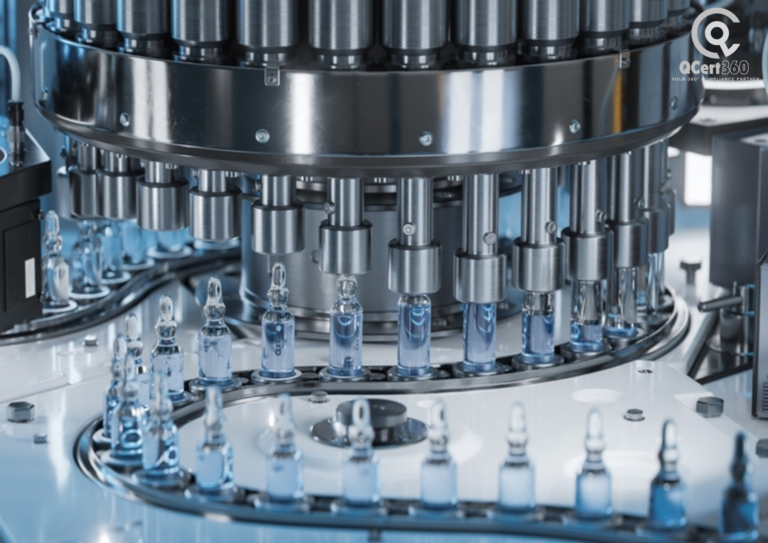
Medical laboratories play a critical role in patient care. From diagnosing illnesses to monitoring treatment outcomes, the accuracy and reliability of lab results can directly affect patient safety. That’s why ISO 15189 certification has become the benchmark for clinical laboratory excellence worldwide. But what is it, why does it matter, and how can labs achieve and maintain this standard? Let’s break it down.
What Is ISO 15189 Certification?
ISO 15189 is an international standard that specifies requirements for quality and competence in medical laboratories. Unlike general quality standards like ISO 9001, ISO 15189 focuses specifically on clinical laboratory certification, emphasizing both diagnostic accuracy and patient safety.
The standard covers all aspects of a lab’s operations, including:
- Staff competence and training
- Equipment calibration and maintenance
- Test methods and validation
- Document control and record-keeping
- Internal audits and continual improvement
Achieving ISO 15189 certification signals to patients, clinicians, and regulators that a laboratory meets the highest standards of reliability and accuracy.
Why ISO 15189 Matters for Medical Labs
Here’s the thing: mistakes in laboratory testing can have serious consequences. Misdiagnoses can lead to incorrect treatments, delayed interventions, or even life-threatening outcomes. ISO diagnostic accuracy standards help prevent these risks by enforcing rigorous quality control measures.
Moreover, laboratories with ISO 15189 accreditation gain:
- Enhanced credibility with hospitals, clinics, and insurance providers
- Competitive advantage in the healthcare market
- Better patient trust and satisfaction
- Streamlined operations through a structured quality management system for laboratories
In short, ISO 15189 isn’t just a certificate; it’s a framework that ensures consistent, accurate results every time.
How to Get ISO 15189 Certification for Labs
Achieving certification might seem daunting, but breaking it down into steps makes it manageable. Here’s a step-by-step ISO 15189 certification process:
- Conduct a Gap Analysis
Assess your current lab processes against ISO 15189 requirements. Identify where your lab is compliant and where improvements are needed. This is crucial before investing in extensive changes.
- Implement a Quality Management System
Design a robust ISO 15189 quality management system for laboratories. This involves documenting processes, defining responsibilities, and creating protocols for testing, calibration, and reporting.
- Staff Training and Competency Evaluation
ISO 15189 emphasizes the importance of qualified personnel. Ensure all staff members are trained in procedures, safety protocols, and internal audit requirements. Competency assessments should be regular and documented.
- Internal Audit and Corrective Actions
Perform regular audits to evaluate compliance with ISO standards. Address non-conformities with corrective actions and track improvements. ISO 15189 internal audit requirements are designed to foster continuous improvement.
- Engage ISO 15189 Consultants
Professional guidance can speed up certification. Experienced ISO 15189 certification consultants help labs navigate documentation, audits, and implementation challenges.
- Certification Assessment
Once prepared, a recognized accreditation body evaluates your lab. The assessment includes reviewing documents, observing laboratory procedures, and interviewing staff. Successful labs receive official accreditation.
- Ongoing Maintenance
Certification isn’t a one-time achievement. Maintain compliance through routine audits, document control, and continual staff training. Maintaining ISO 15189 certification in clinical labs ensures long-term reliability.
Enhancing Patient Safety with ISO 15189 Standards
Patient safety is the ultimate priority for any medical laboratory. Even minor errors in testing can lead to misdiagnoses, incorrect treatment plans, or delays in critical care. This is precisely why ISO 15189 standards play such a crucial role—they create a framework that ensures laboratories operate consistently, accurately, and safely.
Here’s how ISO 15189 improves patient safety in practice:
- Reducing errors through standardized testing procedures: By defining clear protocols for every test, ISO 15189 minimizes variability and human error. Labs can rely on repeatable, reliable procedures for diagnostic testing.
- Ensuring equipment is properly calibrated and maintained: Accurate results depend on functional, precise instruments. The standard mandates regular maintenance, calibration, and validation of all equipment, which safeguards against faulty readings.
- Establishing checks for accurate sample collection, handling, and storage: Pre-analytical errors—such as mislabelled or improperly stored samples—can compromise results. ISO 15189 sets requirements for robust sample management to prevent these issues.
- Implementing document control for laboratories: Effective ISO 15189 document control for laboratories ensures that procedures, results, and audit trails are accurately recorded and readily available. This reduces the risk of misreporting and enables traceability for every test performed.
When a laboratory follows these standards, the entire diagnostic process becomes more reliable. Clinicians can trust the results they receive, and patients benefit from accurate diagnoses and timely treatment. In essence, ISO 15189 is a direct investment in patient care and clinical confidence.
Real-Life Case Study: Pathology Lab Achieving ISO 15189
To see how these standards work in the real world, consider the example of a mid-sized pathology lab in Madrid, Spain. This lab serviced multiple hospitals but faced persistent challenges: test results were sometimes inconsistent, and turnaround times were longer than expected, affecting patient care and clinician trust. Management realized that adopting ISO 15189 accreditation could address these issues and enhance both operational efficiency and patient safety.
The Implementation Process
- Conducted a gap analysis: The lab first compared its current procedures against ISO 15189 requirements. Weaknesses were identified in equipment calibration, documentation practices, and internal controls. This gap analysis provided a clear roadmap for improvements.
- Implemented a structured quality management system for laboratories: A formal ISO 15189 quality management system for laboratories was established, standardizing workflows, defining responsibilities, and documenting every procedure.
- Engaged ISO 15189 consultants: Expert consultants helped streamline staff training, optimize document management, and ensure internal audits were effective and compliant with ISO requirements.
- Regularly conducted ISO 15189 internal audits: The lab carried out routine internal audits to identify non-conformities and apply corrective actions immediately, promoting continuous improvement.
Results and Impact
The improvements had measurable effects within the first year:
- Error rates dropped by 40%, reducing misdiagnoses and the need for repeat tests.
- Sample processing times improved by 30%, enabling faster reporting and quicker clinical decisions.
- Patient satisfaction scores increased significantly, reflecting higher trust in laboratory results.
- Full ISO 15189 accreditation was achieved within 12 months, validating the lab’s competence and commitment to quality.
This case demonstrates that ISO 15189 implementation goes beyond simply meeting regulatory requirements. By adopting these standards, laboratories not only secure certification but also enhance operational efficiency, strengthen staff competence, and, most importantly, improve patient outcomes.
ISO 15189 Implementation Guide for Pathology Labs
Implementing ISO 15189 certification in a pathology lab may seem complex, but breaking it into structured steps makes the process manageable. Here’s a detailed guide to help labs successfully adopt and maintain these standards:
- Document Existing Processes
Start by mapping all lab workflows, tests, and staff responsibilities. This step provides a clear overview of operations and highlights areas where improvements are needed. Accurate documentation forms the foundation of a robust ISO 15189 quality management system for laboratories. - Define Quality Policies
Develop clear policies that prioritize diagnostic accuracy, patient safety, and timely reporting. Quality policies should reflect the lab’s commitment to meeting ISO diagnostic accuracy standards and regulatory expectations. - Train Staff
Well-trained personnel are critical to maintaining quality. Conduct ongoing competency assessments, workshops, and refresher training sessions. This ensures that staff consistently follow standardized procedures and are aware of internal audit requirements. - Develop Standard Operating Procedures (SOPs)
Every test, equipment calibration, and sample handling process should be standardized. SOPs eliminate ambiguity, reduce errors, and enhance overall operational efficiency. This is a core component of ISO clinical laboratory certification. - Control Documents
Implement robust ISO 15189 document control for laboratories. Track revisions, approvals, and updates to all protocols, forms, and records. Digital document management systems can simplify this process and improve traceability. - Monitor Equipment
Regular calibration and preventive maintenance are non-negotiable. ISO 15189 emphasizes equipment reliability because even minor deviations can affect diagnostic results. - Conduct Internal Audits
Schedule routine internal audits to evaluate compliance with ISO standards. Identify non-conformities, apply corrective actions immediately, and track improvements. ISO 15189 internal audit requirements foster a culture of continuous improvement. - Engage External Accreditation Bodies
After internal preparation, coordinate with a recognized accreditation body for formal assessment. Successful evaluation results in official ISO 15189 certification service approval, validating your lab’s competence.
Following this guide ensures that pathology labs meet ISO 15189 requirements efficiently, improve patient safety, and maintain consistent quality.
Common Challenges and How to Overcome Them
Even with a structured implementation plan, labs often face hurdles. Here’s how to address the most common challenges:
- Resistance to Change
Staff may hesitate to adopt new processes or fear additional workload. Emphasize the direct benefits of ISO 15189 standards—fewer errors, improved patient safety, and a stronger professional reputation. Encourage participation in training and decision-making. - Documentation Overload
ISO 15189 requires detailed records, which can feel overwhelming. Digital document management systems streamline document control, reduce manual errors, and simplify compliance with ISO 15189 document control for laboratories. - Maintaining Compliance
Achieving certification is only the first step; ongoing compliance requires commitment. Schedule regular internal audits, monitor equipment, and apply corrective actions promptly to maintain the integrity of the ISO 15189 quality management system for laboratories.
With careful planning, professional guidance, and a culture of continuous improvement, these challenges are entirely manageable, and labs can maintain accreditation effectively.
Benefits of ISO 15189 for Diagnostic Accuracy
The ultimate goal of ISO 15189 is to ensure laboratories deliver accurate, reliable, and timely results. Adopting these standards offers measurable benefits:
- Enhanced Diagnostic Confidence for Clinicians
Accurate lab results allow clinicians to make informed treatment decisions, reducing misdiagnoses and improving patient care. - Improved Patient Outcomes and Safety
Reliable testing reduces errors, supports early detection of diseases, and ensures patients receive appropriate interventions. - International Recognition and Credibility
ISO 15189 accreditation demonstrates that a lab meets global standards, increasing trust among hospitals, insurers, and international partners. - Better Regulatory Compliance
By adhering to ISO standards, labs can navigate national and international regulatory frameworks more easily, avoiding compliance issues and penalties. - Streamlined Lab Processes and Reduced Errors
A structured ISO 15189 quality management system for laboratories optimizes workflows, eliminates redundancies, and ensures consistent, accurate testing results.
In short, ISO 15189 is not just a certification—it’s a framework that transforms laboratory operations, strengthens professional credibility, and most importantly, safeguards patient health.
Conclusion
ISO 15189 certification is more than a badge of honour—it’s a commitment to excellence, accuracy, and patient safety. By following a structured step-by-step ISO 15189 certification process, engaging expert ISO 15189 consultants, and implementing a robust quality management system for laboratories, medical labs can elevate their standards, reduce errors, and gain a competitive edge.
The Spain pathology lab case study demonstrates that the benefits extend beyond compliance: better efficiency, improved patient trust, and long-term sustainability. Whether you are a small diagnostic center or a large clinical lab, ISO 15189 accreditation is an investment in credibility and patient care.
10 FAQs About ISO 15189 Certification
- What is ISO 15189 certification?
ISO 15189 is an international standard specifying quality and competence requirements for medical laboratories. - Why do medical labs need ISO 15189?
It ensures diagnostic accuracy, patient safety, and international recognition. - How long does it take to get ISO 15189 certified?
Typically, 4–6 months, depending on lab size and readiness. - Who issues ISO 15189 accreditation?
Accreditation bodies recognized internationally conduct assessments and issue certification. - What is included in an ISO 15189 quality management system for laboratories?
It includes documentation, SOPs, staff competence, internal audits, equipment maintenance, and process control. - How often should internal audits be conducted?
ISO 15189 requires regular audits; typically, quarterly or semi-annually. - Do small labs benefit from ISO 15189 certification?
Yes. Even small labs gain credibility, better processes, and improved patient safety. - What is ISO 15189 document control for laboratories?
It’s a system to manage, review, and update all lab documents systematically. - Can ISO 15189 certification be maintained indefinitely?
Yes, with ongoing audits, corrective actions, and staff training.
10. How can ISO 15189 consultants help?
They guide labs through implementation, documentation, audits, and ensure a smooth certification process.


